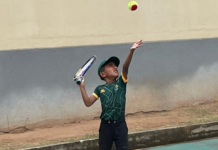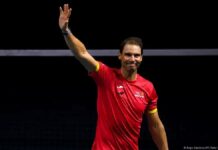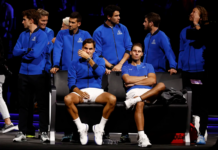As a Real Madrid fan, Rafael Nadal knows all about the significance of ‘La Decima’.
One year after the team he has been known to build his training sessions around won a 10th European Cup, Nadal himself now has the opportunity to become the first man in history to win the same Grand Slam title 10 times.
The Spaniard, who will begin his bid on Tuesday in the second match on Philippe-Chatrier Court, had just turned 12 when his fellow Mallorcan Carlos Moya won the French Open in 1998.
The triumphs of Andre Agassi, Sergi Bruguera and Gustavo Kuerten also made a deep impression on a boy who had first dreamt of winning Wimbledon.
But for the Spanish people, as Nadal readily admits: “Roland Garros is the most special one – because it’s clay.”
Nadal has won 66 of the 67 matches he has contested since making his debut in Paris’s Bois de Boulogne in 2005.
He may have lost more matches on clay this year than in any of the interceding years – his brittle confidence has been exposed by Novak Djokovic, Andy Murray, Stan Wawrinka and Fabio Fognini (twice) – but Roger Federer said unequivocally in Rome that Nadal should start as favourite because of the hold he exerts on the Philippe Chatrier court.
“That moment when you go on court and see the people there,” Nadal tries to explain, “is difficult to describe, but very emotional and very positive.
“I know all the things that happened there with me are difficult to repeat.
Debut win – ‘amazing’ physical performance
Germany’s Lars Burgsmuller was Nadal’s first victim at Roland Garros, and after a semi-final victory over Federer, Mariano Puerta stood between the 19-year-old and a rookie triumph.
Nadal, wearing a lime green sleeveless top, white pirate pants and matching bandana, eventually overwhelmed the Argentine to win in four sets.
When you watch the final again, 10 years on, you can’t fail to notice how Nadal’s style has evolved as much as his dress. The archives reveal an elastic Nadal, bouncing from one side of the court to the other, like a cartoon character who doesn’t comprehend the meaning of a hopeless cause.
“I think I was running more before,” he says, with a laugh, in a BBC Sport interview to mark his assault on a 10th title.
“My physical performance was really amazing at that moment – the way I was able to move and come back from an amazing, tough position.”
The three-time French Open champion Mats Wilander also took a look at the footage from 2005.
“I think he was actually more relaxed in those days,” he points out.
“He’s improved his backhand I think, obviously he’s improved his volleys but I’m not sure that the forehand is better today. I think he hits it flatter and harder sometimes but I think if he watched this, he would go back and say ‘Wow, what happened to my forehand?'”
Greatest triumphs – ‘when you suffer on court’
Nadal’s performance in the final of 2008 – when he allowed Roger Federer just four games – was simply breathtaking, but not one of Nadal’s best memories.
“The stronger memories that you have are when you win difficult matches, when you suffer on court and there is a real battle,” he says.
Recovering from a break of serve down in the final set to beat Novak Djokovic 9-7 in the semi-final of 2013 was “one of the most emotional” victories he has had at Roland Garros. But, when pushed, Nadal chooses two years above all others.
“2006 was a special one because I got a very important injury at the end of the year (a very rare congenital condition in his left foot), and the doctors were not very positive about whether I would be able to be competitive again at the highest level.
“And obviously 2010, after losing in 2009, was very, very special, no?”
The solitary defeat – ‘Wow, this is pretty big’
Sweden’s Robin Soderling remains the only man ever to have beaten Rafael Nadal at Roland Garros.
It happened late on a Sunday afternoon, at the fourth-round stage, and seemed all the more remarkable as Soderling had won just one game when the two met in Rome less than three weeks previously.
“That year had been tough for me,” Nadal recalls.
After winning in Australia, everything was tougher: some personal problems at home (his father told him on the flight back from Melbourne that he and Rafa’s mother were likely to separate) and a lot of problems on my knee. Even if I won so much before the French Open that year my knee was not good, and Robin was playing great.”
Soderling won 6-2 6-7 6-4 7-6, and has vivid memories of the match and the final point.
“I think he missed a volley – I hit a pretty good backhand back down at his feet, and I think he missed it wide,” he accurately recalls.
“After a couple of hours, when I turned on my phone and had all these text messages and was hearing all the reaction from Sweden, I thought to myself ‘Wow, this is pretty big’.
“Playing Rafa you have to be prepared to run like a rabbit for five hours, and there are not many players who physically can do that.”
Trump cards – ‘he’ll do anything to beat you’
Other than forcing an opponent to run like a rabbit, Nadal has an array of tricks which can prove even more devastating when mixed with a dash of clay.
Wilander still sounds awe-struck as he speaks about a practice session he had with Nadal before one of his Roland Garros finals.
“I have never experienced anything like it,” he says. “I could not believe the amount of spin – top spin, side spin, inside out, hook spin – I never got used to it.”
Federer, the winner of 17 Grand Slam titles, but 13 times a loser against Nadal on clay, sums it up like this.
“Clay just helps his game overall because he’s the best mover we’ve ever seen on clay. Because of his sliding, he saves a lot of metres. I think what always shows up is his mental strength and his physical strength: even if you play great, he can still beat you and that’s what makes him the legend he is today.”
The world number 13 Feliciano Lopez was struck by Nadal’s attitude, mental strength and competitive instinct when they first practised together at a Challenger tournament in Spain.
“He wants to win all the time in any game he plays. He will do anything in order to beat you. We play poker sometimes – he’s a great player, aggressive sometimes, but he’s a good poker player I have to say.”
‘The biggest sportsman in Spanish history’
The area of the paddock reserved for the McLaren-Honda Formula 1 team during next week’s Canadian Grand Prix will have a television screen tuned into the tennis, at Fernando Alonso’s request.
The double world champion, who once played alongside Real Madrid goalkeeper Iker Casillas in a charity doubles match against Nadal and an unidentified partner (“Obviously we tried to pass the ball to the other guy all the time”, Alonso recalls) will be doing his best to follow his compatriot’s fortunes.
“He’s an example for all the Spanish people and for all the kids in Spain,” Alonso told BBC Sport.
“Not only for the people on the street but also for us, other sportsmen, when we see him fighting the way he does. He’s never giving up, he’s always believing in his power – it’s very inspirational. In Spain, he’s the biggest sportsman probably in history.”
Lopez agrees. He believes Nadal will make history at Roland Garros a week on Sunday, but argues his achievements stretch much wider – beyond conventional sporting boundaries.
“I think Rafa went further than being a great tennis player,” he says.
“In society in general in Spain everybody loves him as a person. The way he behaves on the court – always fighting till the end – this is what makes the connection with the people possible.
“He is the son that every mum would love to have.”
















